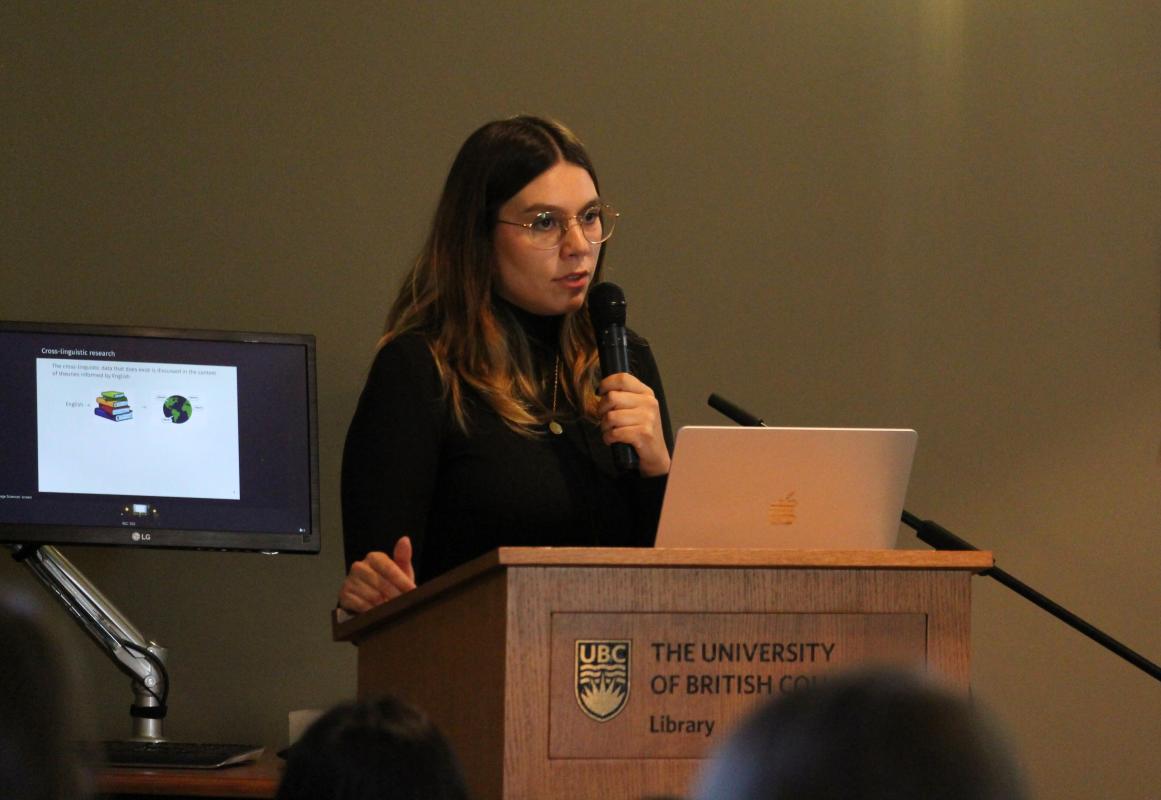When Linguistics PhD student Starr Sandoval first started working with her Ktunaxa consultants, she noticed their enthusiasm in sharing ways to express humour and sarcasm in their language. Though the topic deviated from her original inquiries, it eventually became the ground of her study in non-speaker-oriented expressives in Ktunaxa, which recently won her the Best Talk Award at Language Sciences' Graduate Student and Postdoctoral Research Day.
We spoke to Starr about her learnings from her generous consultants, and the importance of previous research effort that enabled her study in the first place.
Best Talk Award - Starr Sandoval (Linguistics, UBC)
(This is the first of three Q&A with award-winning presenters at the Research Day. To read the rest, please follow the links at the bottom of this article.)
1. Can you briefly describe your research?
I am documenting and analyzing linguistic expressions of humor, sarcasm, surprise known as expressive meaning—in Ktunaxa, a language isolate spoken in Interior British Columbia and parts of the northwestern United States. With community collaborators, I am developing a descriptive resource, pedagogical materials, and elicitation tools to support language revitalization.
2. What got you interested in studying expressives in Ktunaxa?
I've been incredibly lucky to work with four amazing Ktunaxa consultants for the past three years—Vi Birdstone, Dorothy Alpine, Laura Birdstone, and Alfred Joseph have been so kind, generous, and patient in teaching me their language. During my first year of working them, I investigated a variety of grammatical topics, but I found they were always eager to steer the conversation towards ways to express humor and sarcasm, even though this wasn't what I was asking about. I decided that if my consultants were interested in this topic, I should investigate and document it more thoroughly. At the same time, in the the spring of 2022, I enrolled in a seminar on taboo language taught by UBC professors Dr. Marcin Morzycki and Dr. Anne-Michelle Tessier. The course, in part, handled different semantic frameworks for expressive meaning. This background contextualized for me the broader linguistic landscape this work could contribute toward and provided me with ideas for elicitation design and data analysis.
3. Ktunaxa is an extremely endangered language spoken by very few. How did you approach the community and build a working relationship with your consultants?
I was able to start learning and documenting Ktunaxa quite naturally due to the labor and generosity of many others. Former UBC professor Dr. Martina Wiltschko originally initiated the research collaboration with the ʔaq̓am band of Ktunaxa, and UBC (/former UBC) researchers Anne Bertrand, Rose Underhill, Elise McClay, and Terrance Gatchalian maintained this relationship through years of linguistic documentation work, teaching, and community engagement. UBC professor Dr. Ryan Bochnak has also done meaningful work to maintain community relations through leading the field methods class on Ktunaxa for two years and organizing related events. On the UBC side, it's really thanks to all of them that I was able to start working with consultants through a field methods course and the Ktunaxa lab. As mentioned before, Vi, Dorothy, Laura, and Alfred have been nothing but generous and kind as I've elicited with them. I just try to approach each elicitation session knowing I'm incredibly fortunate to be in this position and that I have a responsibility to give back to the Ktunaxa community in whatever way I can.
4. Can you describe your findings, and its greater implications?
The sector of my project I presented at the Language Sciences event related to developing elicitation materials on expressive language for other fieldworkers. If a linguist decides to identify, document, and analyze expressive language in a language that they do not speak, what grammatical features should they look for? What diagnostics should they use? Speaker-orientation is standardly considered a staple of expressive language in at least English, barring some exceptional cases (Potts 2007, Schlenker 2007, Gutzmann 2019). For example, if I said "Floyd thinks my damn car alarm is going off!", 'damn' conveys that *I*, the speaker, am upset—not necessarily Floyd or anyone else. I found that in Ktunaxa, expressives need not be speaker-oriented, and can actually be quite easily interpreted as non-speaker-oriented, more liberally than in English. Thus, while speaker-orientation can be used to look for expressives in English, it is not a reliable diagnostic for identifying expressive language in Ktunaxa.
5. Is the project still ongoing? Do you envisage it to grow into a next phase?
Absolutely :') I'm still examining for example just how liberally the judge of Ktunaxa expressives can be mapped to other individuals, and whether there are contrasts between grammatical categories in this domain (e.g. nouns used to insult people and higher particles used to express disbelief). With respect to the documentation element of this project, I'm creating a booklet and pedagogical materials for the community, but they're still in development.
6. In general, what are your research interest(s)? How can people follow your work?
I am interested in all things semantics, but especially the subdomains of modification and numerals. I work on English and Ktunaxa. If you would like to look more into my projects, you can check out my website. This article is part of the Graduate and Postdoctoral Research Day series. To read the other interviews, please follow the links below.
Read Q&A with Line Lloy, winner of the Best Poster Award at Language Sciences' Graduate and Postdoctoral Research Day 24'.
Read Q&A with Mariana Pinzon-Caicedo, Honarable Mention Award at Language Sciences' Graduate and Postdoctoral Research Day 24'.
